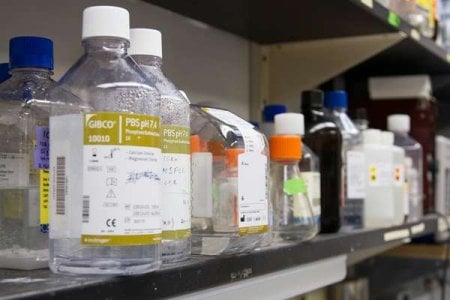‘Threat to humanity’: You might be exposed to these cancer-causing chemicals every day
- Replies 0
Did you know that your body is home to thousands of synthetic chemicals—many of which you’ve never even heard of?
It’s a confronting thought, but according to a new report, chemical exposure is now so widespread that it’s being called a 'threat to humanity.'
And while that might sound like something out of a sci-fi film, the reality is much closer to home than we’d like to think.
A recent eight-month investigation by Deep Science Ventures, a London-based research group, has shone a spotlight on just how deeply these chemicals have infiltrated our lives.
Their findings? The modern industrial economy has created over 100 million chemicals that don’t exist in nature, with somewhere between 40,000 and 350,000 currently in commercial use. Even more alarming, the production of these chemicals has increased fifty-fold since the 1950s.
So, what does this mean for us? Well, for starters, researchers found that more than 3,600 synthetic chemicals from food packaging alone are now present in the human body.
Of these, 80 are considered to be of 'high concern' due to their hazardous properties. And it’s not just food packaging—these chemicals are everywhere: in our water, our air, our homes, and even in the soil where our food is grown.

The report draws a direct line between toxic chemical exposure and a laundry list of health issues, including cancer, obesity, Alzheimer’s, pregnancy complications, ADHD, fertility problems, heart disease, and respiratory ailments.
Perhaps most concerning is the rise in cancer rates, particularly among younger people. Early-onset cancer (diagnosed in people under 50) has increased by a staggering 79% from 1990 to 2019.
One of the main culprits? PFAS, or 'forever chemicals.' These are a group of man-made substances that take thousands of years to break down, earning their ominous nickname. PFAS are used to make products water- and oil-resistant—think non-stick cookware, rain jackets, and even some food packaging. But they don’t stay put.
They leach into our water supply, seep into our food, and ultimately end up in our bodies. In fact, almost every human tested has some level of PFAS in their system, and 14% of European teenagers have blood levels high enough to pose a health risk.
The impact on fertility is particularly worrying. Men with high levels of certain PFAS have been found to have less than half the normal sperm count compared to those with lower levels. And that’s just one example of the many ways these chemicals can disrupt our bodies.
It’s not just PFAS we need to worry about. The report highlights that the food and agricultural industries are among the worst offenders when it comes to chemical pollution.
Pesticides and fertilisers can contaminate water supplies and the food we eat. One particularly concerning practice is the use of sewage sludge from wastewater treatment plants as fertiliser—this sludge often contains a cocktail of toxic chemicals.
And then there are microplastics and nanoplastics—tiny fragments of plastic that are now found everywhere from the deepest oceans to the air we breathe.
Nanoplastics, which are smaller than one micrometre, are especially concerning because they can infiltrate our cells, potentially causing DNA damage and triggering cancer.
You might assume that government agencies are keeping a close eye on these chemicals, but the reality is far from reassuring.
The Deep Science Ventures report found that almost 80% of chemical additives directly added to food in the US lack the information needed to estimate safe consumption levels, and 93% lack data on reproductive or developmental toxicity.
Even in the EU, which is known for its more cautious approach, there are still too many exceptions and not enough long-term data on the health and environmental impacts of commonly used chemicals.
Read more: Plastic piles up on farms and puts Aussie food at risk

Have you noticed changes in your health or the health of your loved ones that you think could be linked to chemical exposure? Do you have tips for reducing toxins in your home? Share your thoughts and experiences in the comments below!
It’s a confronting thought, but according to a new report, chemical exposure is now so widespread that it’s being called a 'threat to humanity.'
And while that might sound like something out of a sci-fi film, the reality is much closer to home than we’d like to think.
A recent eight-month investigation by Deep Science Ventures, a London-based research group, has shone a spotlight on just how deeply these chemicals have infiltrated our lives.
Their findings? The modern industrial economy has created over 100 million chemicals that don’t exist in nature, with somewhere between 40,000 and 350,000 currently in commercial use. Even more alarming, the production of these chemicals has increased fifty-fold since the 1950s.
So, what does this mean for us? Well, for starters, researchers found that more than 3,600 synthetic chemicals from food packaging alone are now present in the human body.
Of these, 80 are considered to be of 'high concern' due to their hazardous properties. And it’s not just food packaging—these chemicals are everywhere: in our water, our air, our homes, and even in the soil where our food is grown.

Experts warn that humans now carry over 3,600 synthetic toxins in their bodies, with many chemicals traced back to food contact materials and industrial processes. Image source: National Cancer Insitute / Unsplash. Disclaimer: This is a stock image used for illustrative purposes only and does not depict the actual person, item, or event described.
The report draws a direct line between toxic chemical exposure and a laundry list of health issues, including cancer, obesity, Alzheimer’s, pregnancy complications, ADHD, fertility problems, heart disease, and respiratory ailments.
Perhaps most concerning is the rise in cancer rates, particularly among younger people. Early-onset cancer (diagnosed in people under 50) has increased by a staggering 79% from 1990 to 2019.
One of the main culprits? PFAS, or 'forever chemicals.' These are a group of man-made substances that take thousands of years to break down, earning their ominous nickname. PFAS are used to make products water- and oil-resistant—think non-stick cookware, rain jackets, and even some food packaging. But they don’t stay put.
They leach into our water supply, seep into our food, and ultimately end up in our bodies. In fact, almost every human tested has some level of PFAS in their system, and 14% of European teenagers have blood levels high enough to pose a health risk.
The impact on fertility is particularly worrying. Men with high levels of certain PFAS have been found to have less than half the normal sperm count compared to those with lower levels. And that’s just one example of the many ways these chemicals can disrupt our bodies.
It’s not just PFAS we need to worry about. The report highlights that the food and agricultural industries are among the worst offenders when it comes to chemical pollution.
Pesticides and fertilisers can contaminate water supplies and the food we eat. One particularly concerning practice is the use of sewage sludge from wastewater treatment plants as fertiliser—this sludge often contains a cocktail of toxic chemicals.
And then there are microplastics and nanoplastics—tiny fragments of plastic that are now found everywhere from the deepest oceans to the air we breathe.
Nanoplastics, which are smaller than one micrometre, are especially concerning because they can infiltrate our cells, potentially causing DNA damage and triggering cancer.
You might assume that government agencies are keeping a close eye on these chemicals, but the reality is far from reassuring.
The Deep Science Ventures report found that almost 80% of chemical additives directly added to food in the US lack the information needed to estimate safe consumption levels, and 93% lack data on reproductive or developmental toxicity.
Even in the EU, which is known for its more cautious approach, there are still too many exceptions and not enough long-term data on the health and environmental impacts of commonly used chemicals.
Read more: Plastic piles up on farms and puts Aussie food at risk
Key Takeaways
- Experts warn that humans now carry over 3,600 synthetic toxins in their bodies, with many chemicals traced back to food contact materials and industrial processes.
- PFAS, or 'forever chemicals', have been detected in nearly all people tested and are linked to serious health issues including cancer, fertility problems, and early-onset illnesses.
- Regulatory loopholes have allowed hundreds of new food additives and chemicals into our food supply without adequate safety testing, with a large proportion lacking public data on long-term health impacts.
- Researchers are calling for urgent action from policymakers and industry to address widespread chemical contamination and prevent irreversible damage to human health and the environment.
Have you noticed changes in your health or the health of your loved ones that you think could be linked to chemical exposure? Do you have tips for reducing toxins in your home? Share your thoughts and experiences in the comments below!







